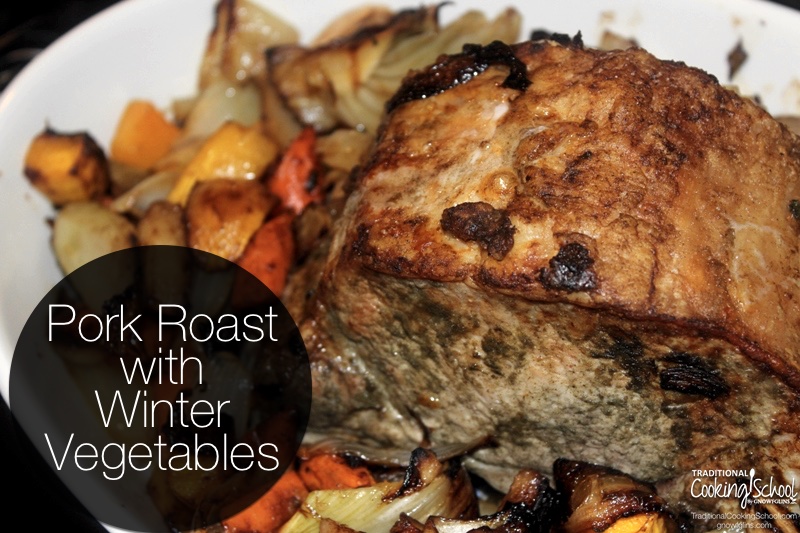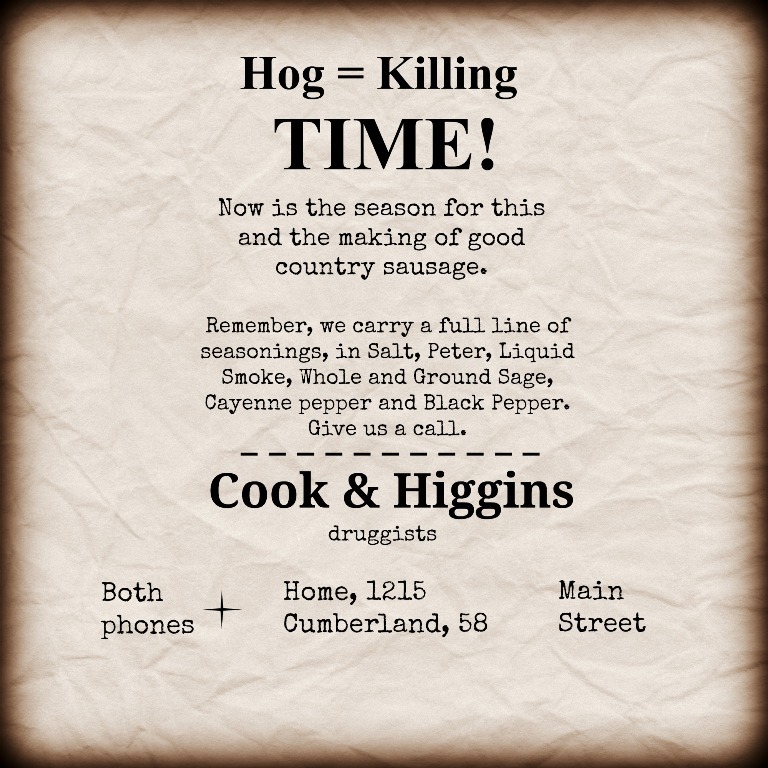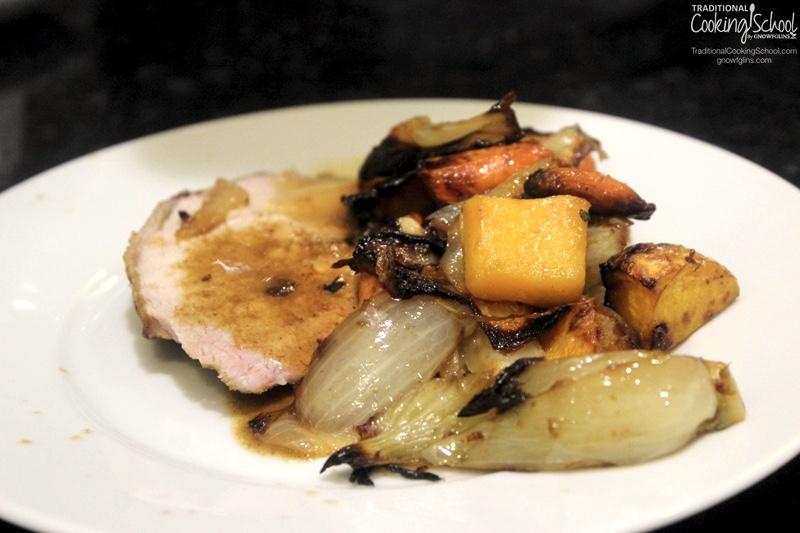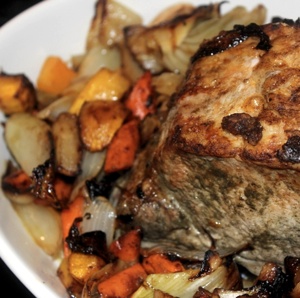
Once upon a time, “seasonal eating” applied to everything — not just spring onions, summer berries, or fall pumpkins. Meats were seasonal, too. Pork was most plentiful in winter when the cold temperatures insured proper hog butchering conditions. According to Mother Earth News, hogs must hang and cool for at least 24 hours before the meat can be sectioned and cured. If you didn’t have a meat locker, you just had to wait for cold weather to hang your hog outside or in a barn.
This page of a Kentucky newspaper from 1905 reports a temperature of just 17 degrees above zero one night. Perfect weather for hog killing! “Freezing weather followed the rain of Saturday, and those who killed hogs slept easier.” Just a week earlier, two Baptist churches had baptized 60 people in the old mill pond. Can you imagine how chilly that water was!

It is important to prepare fresh pork with salt or vinegar before eating it. This originally stemmed from the need to preserve such a highly perishable meat by methods of salting, smoking, curing with saltpeter, or pickling with vinegar. Great gastronomic traditions evolved from these practices, including the charcuterie of Italy and France, and the American tradition of smoked pit barbecue.
These old-fashioned customs gave rise to many more benefits than simple preservation — biochemical changes occur within the cured pork, making it healthier to eat. These studies, conducted by the Weston A. Price Foundation, compare live blood analyses of test subjects who ate fresh and cured pork. This recipe includes a 24-hour marinating period with both salt and apple cider vinegar, helping to tenderize the meat, boost nutrition, and enhance flavor.
Today, the idea of seasonal vegetables is much more intelligible to us than seasonal meats — the winter crops that withstand the harsh frosts and store well in cold frames and root cellars, sharing the vitality of summer sunshine as they nourish us through the cold months.
In this dish, I like to use onions, carrots, turnips, parsnips, butternut squash, and fennel. Feel free to substitute anything you love, or just happen to have around. Leeks, potatoes, kohlrabi, and Brussels sprouts will all be delicious. Use at least 6 cups of cubed or sliced vegetables. I err on the generous side since I love to have plenty of leftovers to saute in butter and top with a fried egg over easy.


Pork Roast with Winter Vegetables
In this dish, I like to use onions, carrots, turnips, parsnips, butternut squash, and fennel. Feel free to substitute anything you love, or just happen to have around. Leeks, potatoes, kohlrabi, and Brussels sprouts will all be delicious.
Ingredients
Marinate
- 2-1/2 to 3 pounds pork roast or pork loin roast
- 2 tablespoons raw apple cider vinegar
- 1 teaspoon sea salt
- 1 teaspoon dried sage
Roast:
- 1 fennel bulb about 1-1/2 pounds
- 2 small onions
- 2 to 3 cups butternut peeled and cubed, or other winter squash
- 3 large carrots
- 1 to 2 cups rutabaga peeled and cubed, or turnip
- 1 to 2 medium parsnips
- 2 tablespoons grass-fed butter
- 2 tablespoons extra virgin olive oil
- 1 teaspoon sea salt
- 1 teaspoon sage fresh, minced
- 1/2 teaspoon ground black pepper freshly ground
Sauce:
- 3/4 cup chicken broth
- 1/2 cup white wine
- 2 teaspoons Dijon mustard
- 2 tablespoons grass-fed butter
Instructions
Marinate:
-
One to two days before you want to serve this dish, place pork roast in nonreactive container and add ACV, 1 teaspoon of the salt, and dried sage.
-
Rub mixture into pork.
-
Allow to marinate in the refrigerator for between 24 and 48 hours.
Roast:
-
Preheat oven to 400 degrees Fahrenheit.
-
Trim stalks away from fennel and cut bulb into 8 wedges.
-
Peel onions and cut each onion into 8 wedges.
-
Peel carrots and parsnips and cut them into 1 to 2-inch chunks depending on thickness.
-
You want everything fairly uniform in size.
-
Peel and cube squash and turnips.
-
Melt over medium high heat 1 tablespoon of butter and 1 tablespoon of olive oil in a large skillet, Dutch oven or oven/stove safe roasting pan.
-
Add the fennel and onion and saute, stirring frequently, for about 5 minutes or until slightly brown on edges.
-
Remove from the pan.
-
Add 1 more tablespoon of butter and oil each.
-
Add carrots, parsnips, squash, and turnip to the pan.
-
Saute about 5 minutes or until lightly browned, and remove from the pan.
-
Remove the marinated pork from the refrigerator and place into the pan, fat side up.
-
Arrange all of the sauteed vegetables around the pork.
-
Sprinkle the vegetables with the fresh sage, remaining teaspoon of salt, and freshly-ground pepper.
-
Bake in oven for 45 minutes, then reduce heat to 350 degrees Fahrenheit and continue to cook for an additional 30 to 45 minutes until the pork reaches an internal temperature of 160 degrees Fahrenheit.
Sauce:
-
Remove the pork and vegetables from the pan to a serving platter.
-
Cover loosely with foil to keep warm.
-
Meanwhile, place the pan over medium heat and combine the broth, wine, and mustard.
-
Simmer for 4 minutes.
-
Whisk in the last 2 tablespoons of butter, 1 tablespoon at a time, and then remove from heat.
-
Serve slices of pork with the roasted vegetables and sauce.
Recipe Notes
- Use at least 6 cups of cubed or sliced vegetables.
Enjoy! Share in the comments if you have a favorite way to roast pork, or if you give this recipe a try!
We only recommend products and services we wholeheartedly endorse. This post may contain special links through which we earn a small commission if you make a purchase (though your price is the same).


Lee this sounds so good! We love pork. I like your idea for utilizing the leftover vegetables. My husband would really like those with a fried egg.
I am thrilled to have found your recipe. Our family loves roasted pork in the summer. I usually cook more pork and use the leftovers for meals throughout the week. No matter how many vegetables I cook, we never seem to have leftovers. You’ve given me some good ideas for different vegetables I could add too. I have used potatoes, onions and carrots. Next time, I will add as many of the suggested veggies as possible. Maybe then, we’ll have leftovers to use with the egg idea. :O) Thanks for sharing!
Oooops! I meant to say winter.
Good luck with getting some leftover veggies – Maybe if you take some out beforehand you can set them aside without anyone catching on. 🙂
Delicious! However, my pork turned out a little dry. I also turned the sauce into a gravy which brought out those favors better, too.
Thanks for the feedback Patty. I have found that the pasture-raised pigs can vary wildly in their fat content. Some breeds stay nice and moist, others have a tendency to dry out. I would suggest putting a little extra lard on top, or maybe some salt pork on top to keep it from drying out if you find you have a very lean piece of meat.
I pinned this when you posted it on facebook. I made it tonight. I marinated it for 48 hours. I doubled the recipe, because I have a large family and they devoured it. There is nothing left! My husband told me it is one of the best meals he has ever had! Thank you for the recipe and this website. Love cooking and serving my family food I can feel good about!
awwww – thanks Amanda! So glad you enjoyed it! Thank you for the great feedback! It’s such an encouragement to hear from people!